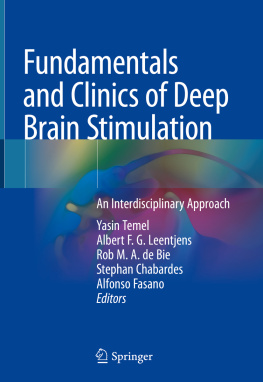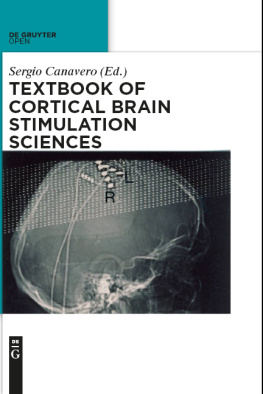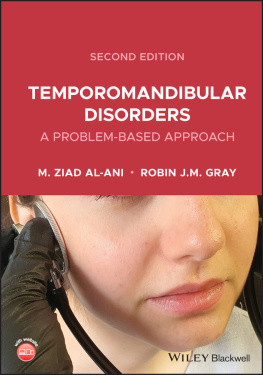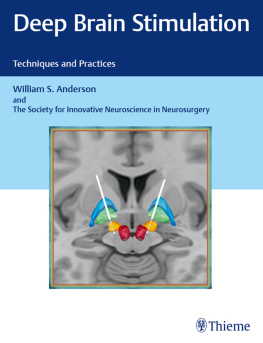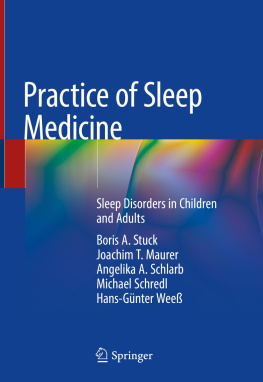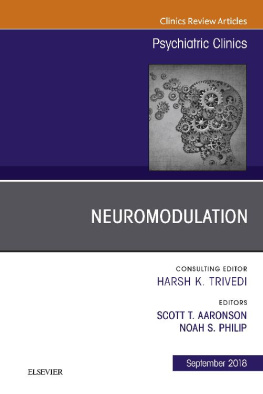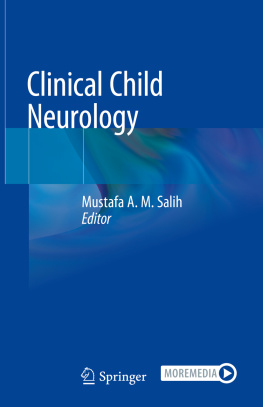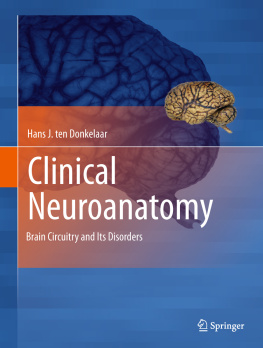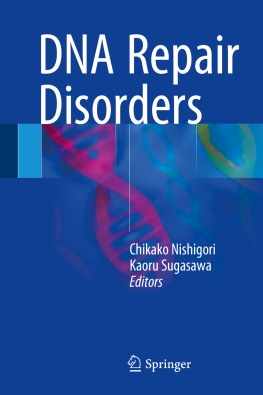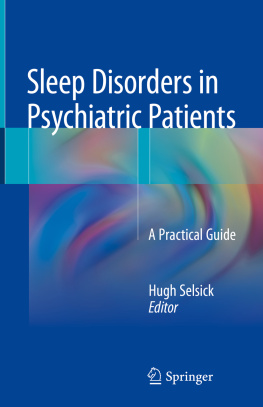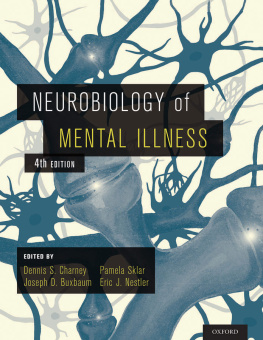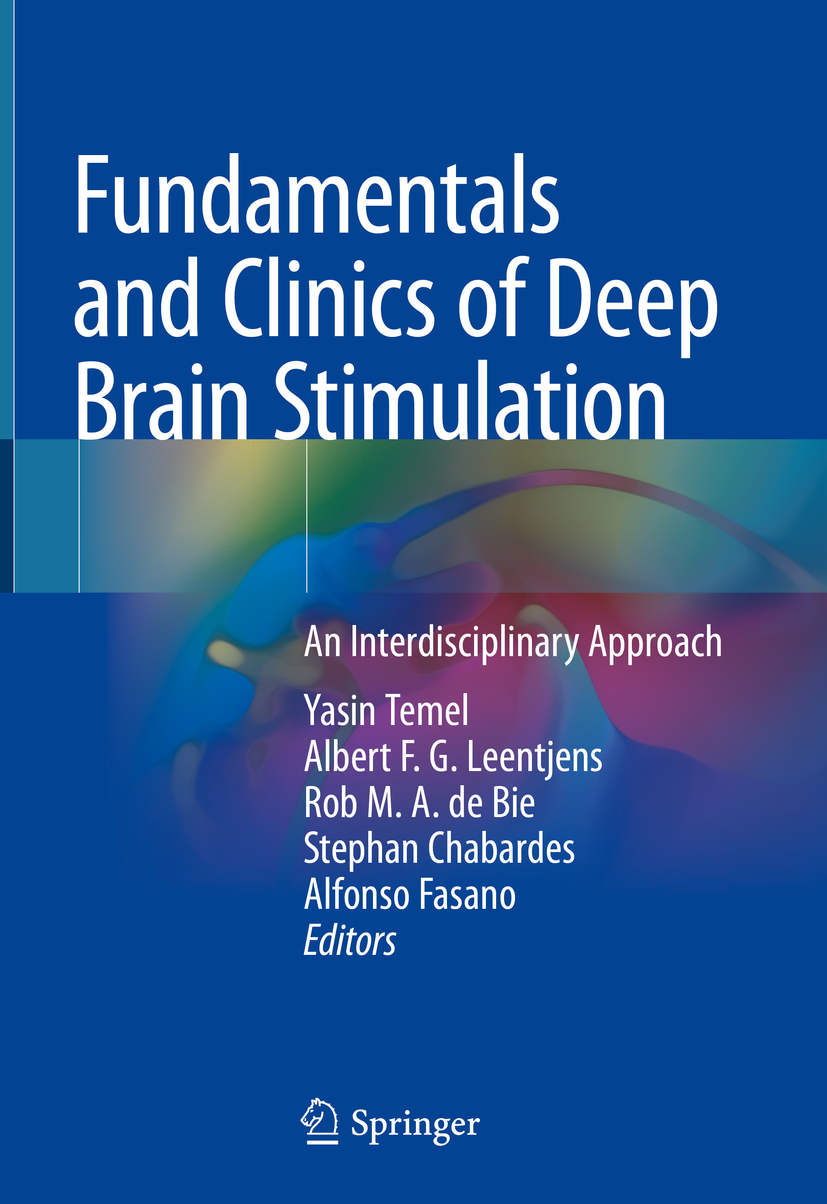Editors
Yasin Temel , Albert F. G. Leentjens , Rob M. A. de Bie , Stephan Chabardes and Alfonso Fasano
Fundamentals and Clinics of Deep Brain Stimulation
An Interdisciplinary Approach
Editors
Yasin Temel
Department of Neurosurgery, Maastricht University Medical Centre, Maastricht, The Netherlands
Albert F. G. Leentjens
Department of Psychiatry, Maastricht University Medical Centre, Maastricht, The Netherlands
Rob M. A. de Bie
Department of Neurology, Amsterdam Neuroscience, University of Amsterdam, Amsterdam, Noord-Holland, The Netherlands
Stephan Chabardes
Department of Neurosurgery, Grenoble University Hospital Center, Grenoble, France
Alfonso Fasano
Morton and Gloria Shulman Movement Disorders Clinic, Toronto Western Hospital, Toronto, ON, Canada
ISBN 978-3-030-36345-1 e-ISBN 978-3-030-36346-8
https://doi.org/10.1007/978-3-030-36346-8
Springer Nature Switzerland AG 2020
This work is subject to copyright. All rights are reserved by the Publisher, whether the whole or part of the material is concerned, specifically the rights of translation, reprinting, reuse of illustrations, recitation, broadcasting, reproduction on microfilms or in any other physical way, and transmission or information storage and retrieval, electronic adaptation, computer software, or by similar or dissimilar methodology now known or hereafter developed.
The use of general descriptive names, registered names, trademarks, service marks, etc. in this publication does not imply, even in the absence of a specific statement, that such names are exempt from the relevant protective laws and regulations and therefore free for general use.
The publisher, the authors, and the editors are safe to assume that the advice and information in this book are believed to be true and accurate at the date of publication. Neither the publisher nor the authors or the editors give a warranty, expressed or implied, with respect to the material contained herein or for any errors or omissions that may have been made. The publisher remains neutral with regard to jurisdictional claims in published maps and institutional affiliations.
This Springer imprint is published by the registered company Springer Nature Switzerland AG
The registered company address is: Gewerbestrasse 11, 6330 Cham, Switzerland
Deep brain stimulation mechanisms. (a) Neurotransmitters (inset) are released in response to stimulation, leading to calcium waves and subsequent release of gliotransmitters. This release influences synaptic plasticity, leading to arteriole dilation and increased regional blood flow. (b) Deep brain stimulation (DBS)-induced changes in local field potentials within the subthalamic nucleus. Activity in the beta band is rapidly reduced with DBS at 3 V and then resumes with stimulation off. Adopted with permission from Lozano et al., Nature Reviews Neurology, 15, pages 148160 (2019)
Preface
The interest in deep brain stimulation (DBS) as a treatment option for neurological and psychiatric disorders is rapidly growing. The first application of modern DBS started in the late 1980s with a patient suffering from tremor-dominant Parkinsons disease. The history of using electrical current to suppress symptoms of disease in an experimental setting has since gone far beyond this milestone. DBS has become an accepted therapy for patients with a number of neurological and psychiatric disorders that are refractory to more conservative pharmacological and/or psychotherapeutic treatments. These include essential tremor, dystonia, epilepsy and obsessivecompulsive disorder. These, as well as other, new, indications for which DBS is being evaluated, are discussed in this book.
Two developments have contributed to increased popularity of DBS. The first one is the increased understanding of disease mechanisms that lead to symptoms. We have learned that neurological or psychiatric disorders lead to disrupted activity in a specific brain region or a specific brain pathway, resulting in specific symptoms. A good example is altered activity in the subthalamic nucleus being responsible for key symptoms of Parkinsons disease. DBS of the subthalamic nucleus suppresses this altered activity and relieves these motor symptoms. Another example is tremor, which is linked to tremor cells that can be found in the motor part of the thalamus. When DBS is applied in this region, the tremor can be stopped. Similar mechanisms play a role in obsessivecompulsive disorder. DBS of limbic parts of the basal ganglia improves severe obsessions and compulsions. The second reason for the increased interest in DBS is the limited progress in new drug development for neurological and psychiatric diseases. The limited accessibility of the brain due to the bloodbrain barrier and the non-selective nature of most drugs are major challenges for drug development.
Authors from different disciplines, from many different countries, have contributed their expertise and personal experience to this book. This book provides the latest insights in disease mechanisms, brain anatomy and function, and clinical symptomatology of neurological and psychiatric disorders that are considered indications for DBS. In addition, specific patient management skills and DBS treatment strategies are outlined. Basic and advanced concepts of stimulation protocols, necessary knowledge regarding hardware and software are included as well. The composition of the editors, neurologists, neurosurgeons and psychiatrist reflects the multidisciplinary nature of the field. The editors hold that a well-integrated and dedicated multidisciplinary team, with up-to-date knowledge of the possibilities of DBS treatment, is an essential requirement for successful therapy.
Yasin Temel
Albert F. G. Leentjens
Rob M. A. de Bie
Stephan Chabardes
Alfonso Fasano
Maastricht, The Netherlands Maastricht, The Netherlands Amsterdam, The Netherlands Grenoble, France Toronto, ON, Canada
August 2019
Contents
Part IGeneral Section
J. D. Hans Speelman and Rick Schuurman
Ali Jahanshahi , Juergen K. Mai and Yasin Temel
Abdelhamid Benazzouz and Clement Hamani
Rick Schuurman and Stephan Chabardes
Martijn Beudel , Margot Heijmans , Jeroen G. V. Habets and Pieter L. Kubben
Boran Urfal , Yasin Temel and Hagai Bergman
Michal J. Bos , Boukje J. E. Hermans and Wolfgang F. Buhre
Clecio de Oliveira Godeiro Jr , Elena Moro and Erwin B. Montgomery Jr
Marjan Jahanshahi
Dorothee Horstktter and Guido de Wert
Rianne A. J. Esselink and Mark L. Kuijf
Part IINeurology
Timo R. ten Brinke , Martijn Beudel and Rob M. A. de Bie
Alfonso Fasano and Volker Arnd Coenen
Maria Fiorella Contarino and Joachim K. Krauss
Kai Lehtimki and Jukka Peltola
Anouk Y. M. Smeets , Albert F. G. Leentjens and Linda Ackermans

